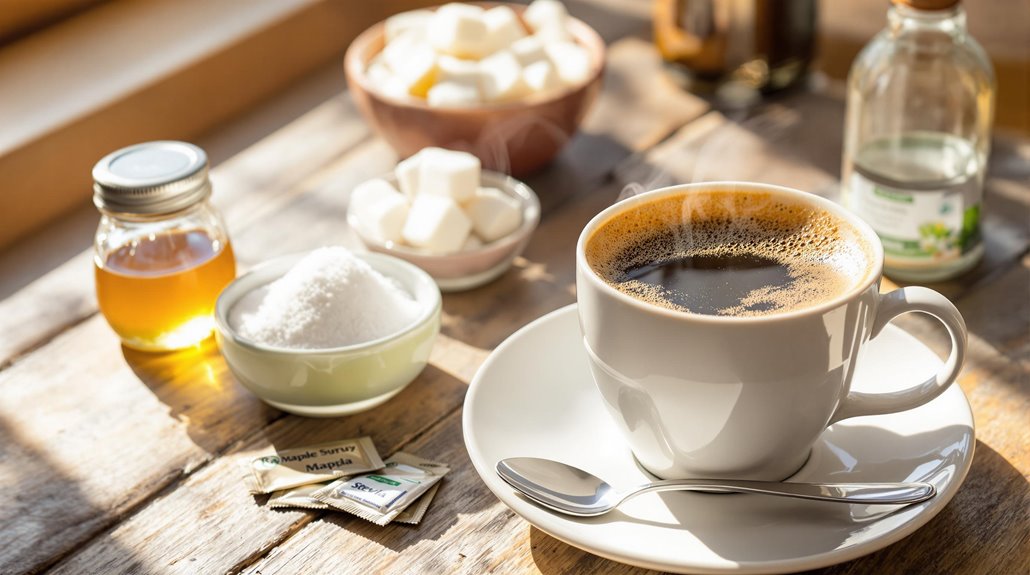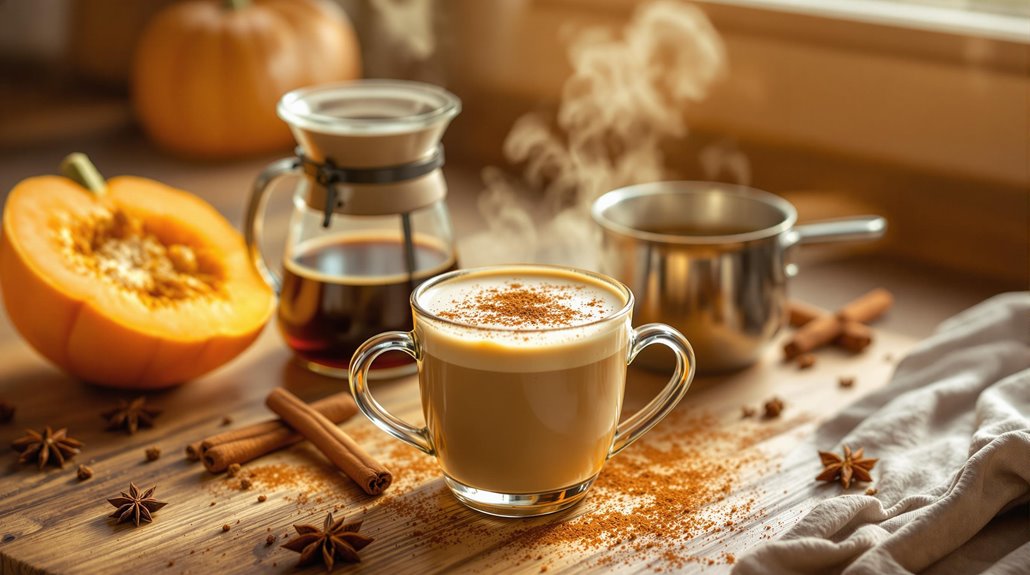







Making a homemade latte might seem intimidating, but it's simpler than you think. You'll need just a few key ingredients and tools to get started, and the process can be tailored to fit your preferences. Whether you're using an espresso machine or a budget-friendly alternative, the secret lies in balancing rich espresso with perfectly steamed milk. But how do you achieve that creamy texture without professional equipment? And what if you want to experiment with flavors or milk alternatives? The answers could transform your morning routine—or even spark a new hobby. Let's break it down step by step.
Key Takeaways
- Brew 2 shots of espresso using finely ground coffee beans and an espresso machine or alternative like a Moka pot or Aeropress.
- Steam 8 oz of whole milk to 150-160°F using a steam wand or frother for a creamy, velvety texture.
- Combine espresso and steamed milk in a pre-warmed cup, topping with a light layer of foam for a classic latte.
- Customize with flavored syrups like vanilla, caramel, or seasonal options such as pumpkin spice or gingerbread.
- Use fresh coffee beans and clean equipment for optimal flavor and consistency in your homemade latte.
Understanding the Basics of a Latte
A latte is built on a foundation of espresso, steamed milk, and a light layer of foam, with a standard ratio of 1 part espresso to 3 parts milk. To craft a 12-ounce latte, you'll need 2 shots of espresso and about 8 ounces of milk. The espresso should be brewed to perfection, with a rich crema forming on top, ensuring a bold base for your coffee drink. When frothing the milk, aim for a velvety texture by steaming it to around 150°F, creating microfoam that blends seamlessly with the espresso. Unlike a cappuccino, which has more foam, a latte's creamy consistency comes from its higher proportion of steamed milk and minimal milk foam. You can elevate your homemade latte recipe by adding flavored syrups like vanilla, caramel, or seasonal options. Mastering the balance of brewing espresso and frothing milk is key to achieving a professional-quality latte at home. With practice, you'll create coffee drinks that rival those from your favorite café.
Essential Ingredients for a Homemade Latte
To make a homemade latte, you'll need two key components: freshly brewed espresso and properly steamed milk. Start with 2 shots of espresso (about 2 ounces) made from high-quality coffee beans ground finely for ideal flavor. If you don't have an espresso machine, strong brewed coffee can work as a substitute. For the milk, use 6-8 ounces of whole milk, which froths best due to its higher fat content, creating a rich, creamy texture. If you prefer non-dairy alternatives, oat or almond milk are excellent options for achieving a similar consistency. Steam the milk until it reaches 150-160°F, ensuring it's hot but not scalded. Froth the milk to create a velvety microfoam, which adds a smooth layer of milk foam to your latte. Customize your drink with sweeteners like sugar, honey, or flavored syrups such as vanilla or caramel. For a finishing touch, top your latte with a thin layer of milk foam or a sprinkle of cinnamon. These ingredients, combined with precise measurements and technique, will elevate your homemade lattes to café-quality perfection.
Brewing Espresso Without a Machine
When you don't have an espresso machine, you can still brew a strong, concentrated coffee that mimics espresso using simple tools like a Moka pot, Aeropress, or French press. For a Moka pot, fill the bottom chamber with water up to the valve, add finely ground coffee to the filter basket, and assemble the pot. Heat it on the stove until the water boils and forces steam through the coffee, creating a rich espresso substitute. With an Aeropress, use a 1:2 coffee-to-water ratio—add 18 grams of freshly ground coffee and 36 grams of water, stir for 10 seconds, then press slowly for a concentrated brew. If using a French press, aim for a 15:1 water-to-coffee ratio, steep for 4 minutes, and press gently to extract strong coffee. Always use finely ground coffee for a more authentic espresso-like result. These methods allow you to brew your espresso at home without specialized equipment, ensuring a robust base for your homemade latte.
Frothing Milk at Home: Simple Methods
Heat milk to 150°F-155°F, then pour it into a mason jar, filling it halfway, and shake vigorously for 30-45 seconds until it doubles in volume. If you don't have a frother, use a whisk or handheld frother to create microfoam by moving it in a circular motion for 20-30 seconds. For consistent results, an electric frother can automate the process, ensuring creamy, velvety foam every time.
Mason Jar Technique
The mason jar technique offers a straightforward way to froth milk at home without specialized equipment. Start by heating the milk in a mason jar until it's warm but not boiling, ensuring the lid is off to prevent pressure buildup. Use whole milk for best frothiness due to its higher fat content, or choose a non-dairy alternative like oat milk. Once heated, secure the lid tightly and shake the jar vigorously for 30-60 seconds until the milk doubles in volume and becomes frothy. Carefully remove the lid and microwave the jar for 30 seconds to stabilize the foam. While the milk froths, brew espresso using your preferred method. Pour the espresso into your mug, then gently pour the frothy milk over it, holding back the foam with a spoon. Finally, spoon the remaining foam on top to complete your homemade latte. This method delivers a creamy, café-quality drink with minimal effort.
Alternative Frothing Tools
While the mason jar method is a reliable way to froth milk at home, there are other tools that can achieve similar or even better results. A hand-held milk frother is a compact, affordable option that creates rich foam in seconds. Simply heat your milk to 150°F (65°C), submerge the frother, and whisk until you achieve a creamy texture. For larger batches, an immersion blender works well; blend heated milk in a tall container until frothy. If you prefer a manual approach, whisking heated milk in a saucepan or bowl can also yield excellent results, especially with whole milk, which froths best due to its higher fat content. For non-dairy alternatives like oat milk, verify it's barista-grade for peak frothing. Each method requires precise heating—avoid boiling to prevent scorching—and consistent whisking or blending to incorporate air evenly. Experiment with these tools to find the one that suits your latte-making routine, whether you're aiming for velvety microfoam or a light, airy froth.
Choosing the Right Milk for Your Latte
Selecting the right milk for your latte can make or break your coffee experience. Whole milk is the gold standard for frothing, thanks to its high fat content, which creates a rich, creamy texture perfect for lattes. If you're aiming for a velvety microfoam, whole milk's natural creaminess guarantees a smooth pour and balanced flavor. For non-dairy options, barista blends are your best bet. These are specially formulated to froth well, mimicking the texture of whole milk. Oat milk, for instance, froths beautifully and offers a similar creaminess, while almond milk adds a subtle nutty flavor but requires careful frothing to avoid separation. Skim or low-fat milk can work, but they produce less foam and a thinner texture, resulting in a lighter latte. When frothing, aim for a temperature of 140–155°F to avoid scalding and maintain the milk's natural sweetness. Whether you choose whole milk, almond milk, or a barista blend, the right milk guarantees your latte has the perfect balance of texture and flavor.
Step-by-Step Guide to Assembling a Latte
Once your espresso is brewed and your milk is frothed to perfection, it's time to assemble your latte. Start by brewing 1-2 shots of espresso (1-2 ounces) using an espresso machine or a stovetop Moka pot. Pour the brewed espresso into a pre-warmed cup to maintain its temperature. Next, heat 6-8 ounces of milk and use a milk frother or steam wand to create steamed milk with a layer of foamed milk on top. Slowly pour the steamed milk into the cup, holding back the foam with a spoon to let the milk blend with the espresso. Once the cup is nearly full, spoon the foamed milk on top to create a velvety layer. If you're skilled, you can even create latte art by carefully pouring the foam. To make a latte at home truly your own, you can customize your latte with flavored syrups or sweeteners, but avoid overloading the drink to preserve the balance of flavors. This step-by-step process guarantees a professional-quality latte every time.
Customizing Your Latte With Flavors
Start by adding 1-2 ounces of flavored syrup, like vanilla or caramel, to your espresso shot before pouring in 6-8 ounces of steamed milk. For seasonal twists, try 1 ounce of pumpkin spice or peppermint mocha syrup to complement your double shot of espresso. Adjust the milk froth to a velvety microfoam consistency to guarantee the flavors blend seamlessly with your latte.
Popular Flavor Additions
For a latte that stands out, you can elevate its flavor profile by incorporating popular additions like vanilla, mocha, or caramel, which add sweetness and depth. Start by adding 1-2 ounces of flavored syrups, such as vanilla or caramel, to your espresso shot before steaming the milk. This guarantees the flavors blend seamlessly. If you prefer a richer taste, try pumpkin spice syrup for a seasonal twist. To customize sweetness, adjust the amount of syrup or use alternative sweeteners like honey or simple syrup. For a unique flavoring, experiment with brown sugar, rosemary, or ginger to create a distinctive latte. When frothing milk, especially non-dairy milk like oat or almond, make sure it's heated to 140-150°F for ideal texture and flavor integration. These additions not only enhance the drink but also allow you to tailor it to your preferences. Whether you're using traditional dairy or non-dairy milk, flavored syrups and unique flavorings can transform your homemade latte into a personalized masterpiece.
Seasonal Syrup Options
Seasonal syrup options let you infuse your homemade latte with flavors that match the time of year, creating a drink that feels both fresh and familiar. Use 1-2 ounces of flavored syrup per 12 oz latte to balance sweetness without masking the espresso's rich notes. For fall, pumpkin spice syrup adds warmth with cinnamon, nutmeg, and clove. In winter, gingerbread syrup brings a cozy, spiced depth to your latte recipes. Spring and summer call for lighter options like vanilla syrup or floral lavender-infused simple syrups.
Making homemade flavored syrups is simple: dissolve equal parts sugar and water over low heat, then add spices, extracts, or herbs. This lets you customize sweetness and intensity to suit your taste. For example, steep ginger and molasses for gingerbread syrup or blend vanilla beans for a smooth, aromatic vanilla syrup.
Experiment with seasonal syrups to elevate your latte game. Whether you're crafting a holiday-inspired drink or a revitalizing spring treat, these simple syrups let you tailor your latte to the season while showcasing your espresso expertise and milk frothing skills.
Tools and Equipment for Making Lattes
To craft a homemade latte, you'll need a few essential tools and equipment to guarantee precision and quality. Start with an espresso machine or a stovetop Moka pot to brew your espresso. Use finely ground coffee and make sure the water temperature stays between 195°F and 205°F for ideal extraction. A milk frother or steam wand is indispensable for creating silky microfoam; handheld frothers or automatic frothing machines work well with any type of milk. If you don't have a frother, a blender can be used to froth heated milk, though it may require more effort to achieve the same creamy texture. Measuring cups and spoons are vital for portioning milk (6-8 ounces per latte) and adding sweeteners or syrups to taste. Finally, always use a pre-warmed serving cup to maintain the latte's temperature and enhance the drinking experience. With these tools, you'll have everything needed to master the art of latte-making at home.
Tips for Perfecting Your Homemade Latte
Start by choosing whole milk for its creamy texture or oat milk for a non-dairy option, ensuring it froths well. Steam your milk to 150°F-155°F, doubling its volume for smooth microfoam without large bubbles. Pair 2 shots of espresso (2 ounces) with 6-8 ounces of steamed milk for a balanced 1:3 ratio.
Choosing the Right Milk
Your latte's texture and flavor hinge on the milk you choose. Whole milk is the gold standard for a latte, as its higher fat content creates a creamy texture and ideal frothing. If you prefer non-dairy alternatives, oat milk is a standout option, offering a similar creamy texture and excellent froth. For the best results, heat milk to 150°F to 155°F, ensuring it's warm enough for frothing and steaming without scalding. Barista-style milk, specifically designed for frothing and steaming, can elevate your homemade latte by producing stable, velvety foam. If you're feeling adventurous, flavored milks like vanilla or chocolate almond milk can add a unique twist to your drink while still achieving a decent froth. Avoid ultra-pasteurized milk, as it can hinder frothing. Always use fresh, cold milk for the best results, and experiment with different types to find your perfect match. Whether you stick with whole milk or explore non-dairy alternatives, the right milk will transform your latte into a barista-worthy creation.
Mastering Milk Frothing Techniques
Once you've selected the right milk for your latte, the next step is mastering the art of frothing. To make a latte with a creamy texture, start by heating your milk to 150°F-155°F. Whole milk works best due to its higher fat content, but if you prefer a non-dairy alternative, oat milk froths exceptionally well. Use a frother to create microfoam by submerging the wand just below the milk's surface, allowing small, velvety bubbles to form. If you don't have a frother, heat the milk and shake it vigorously in a mason jar or whisk it in a saucepan until frothy. The goal is to achieve frothed milk that's smooth and silky, not overly bubbly. When combining with espresso, pour the frothed milk slowly into the center of the shot, then tilt the cup and move the milk in a circular motion to create latte art. Mastering these milk frothing techniques guarantees your homemade latte has the perfect balance of espresso and creamy texture, elevating your coffee experience.
Balancing Espresso and Milk Ratios
A latte's essence lies in its perfect balance of espresso and milk, a harmony that transforms a simple drink into a barista-quality creation. To make a homemade latte, start with a standard ratio of 1 part espresso to 3 parts steamed milk. For a 12-ounce latte, use 1 shot of espresso (about 1 ounce) and 8 ounces of milk, topped with a thin layer of foam. If you prefer a stronger espresso flavor, reduce the milk slightly, or increase it for a creamier texture. Whole milk works best for frothing due to its fat content, creating a rich, velvety consistency, but non-dairy options like oat milk can also froth well. When steaming milk, aim for a smooth, glossy texture without large bubbles. To sweeten your latte, add flavored syrups or a touch of sugar, but make sure they complement rather than overpower the espresso and milk ratio. Experiment with these proportions to tailor the flavor to your taste, keeping the core balance intact for a consistently delicious homemade latte.
Exploring Latte Variations and Recipes
Experimenting with latte variations and recipes opens up a world of possibilities for crafting your perfect cup. Start with the classic homemade latte: combine 1 shot of espresso with 3 parts steamed milk, topped with a thin layer of foam. Adjust the espresso-to-milk ratio to intensify the coffee flavor or create a creamier texture. For flavored options, add syrups like vanilla, caramel, or hazelnut to your espresso before pouring in the steamed milk. Seasonal favorites, such as pumpkin spice or peppermint, offer delightful customization. If you prefer a cold drink, try an iced latte by pouring freshly brewed espresso over ice and adding cold milk or flavored syrups. Explore different types of milk, like oat, almond, or whole milk, to alter the frothing ability and taste. Each milk type impacts the latte's texture and flavor profile, allowing you to tailor it to your preferences. Whether you're crafting a rich, bold latte or a light, sweet iced version, mastering these variations guarantees every sip is uniquely yours.
Disclosure: As an Amazon Associate, I earn from qualifying purchases.






